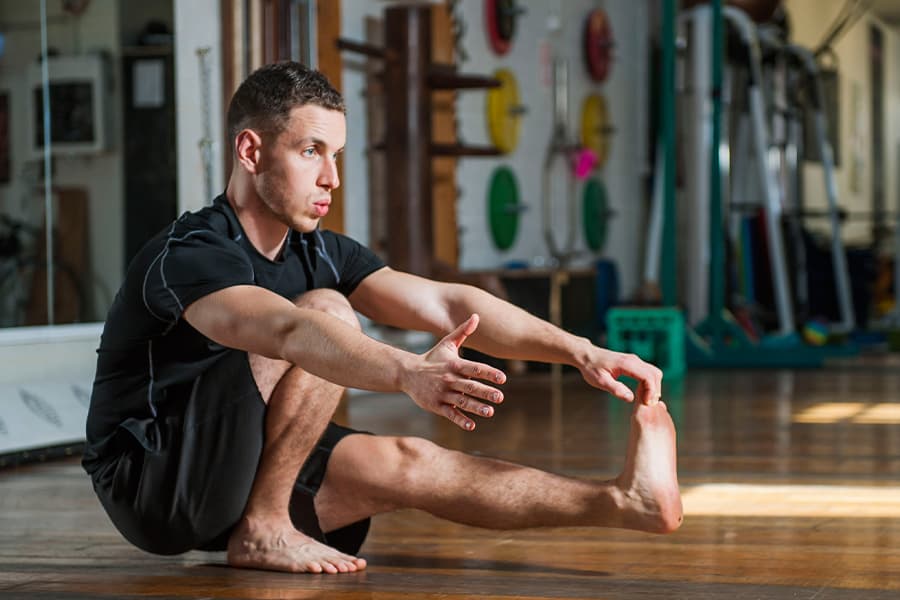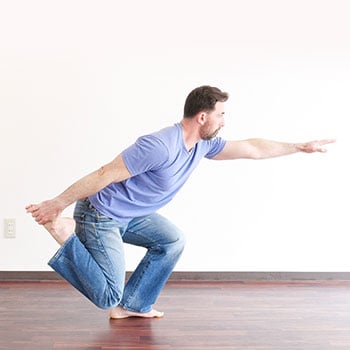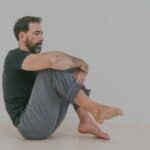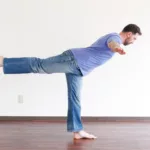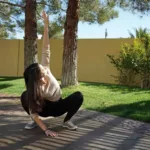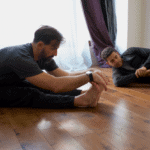If you’ve been struggling to get a solid pistol squat, it’s probably not your fault. The way it’s usually taught sets you up to fail.
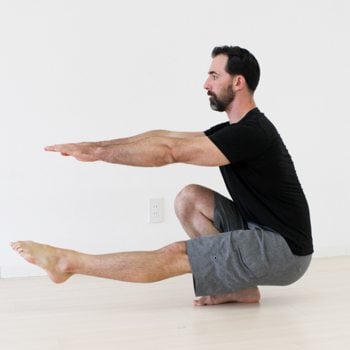 The pistol squat (commonly called the single leg squat) is a hard skill to learn. It takes a really complex mix of specific strengths, flexibilities, and areas of motor control. But most tutorials just show you how to lower yourself a little more and a little more until you hit the ground (and then you’re at the mercy of a friend or kind stranger to help you back up).
The pistol squat (commonly called the single leg squat) is a hard skill to learn. It takes a really complex mix of specific strengths, flexibilities, and areas of motor control. But most tutorials just show you how to lower yourself a little more and a little more until you hit the ground (and then you’re at the mercy of a friend or kind stranger to help you back up).
If your goal is to just get down into the pistol squat once to say you did it, sure, this will probably eventually work.
But if you want to get the full benefits of this skill—new capabilities that spill over into other parts of your training and your life—you’re gonna need to find a better way.
Luckily, that’s just what I have for you in this tutorial.
I’m going to show you how to learn the pistol squat the same way we teach complex physical skills in our Training Programs, where we start by assessing your current abilities, then addressing your weaknesses, and finally applying the new skills you’ve learned.
And you’ll see how it will help you both get the pistol squat faster, and benefit more from practicing the skill.
But first, give this 1 minute video a watch. You’ll see Ryan take you through a quick progression of the Pistol squat.
We go way more in-depth with the tutorial below.
How Does Your Pistol Squat Stack Up?
The first step in addressing your pistol squat head-on is to assess where you’re at right now.
We’ll start by simply attempting a pistol squat. Extend one leg in front of you, lower down slowly, and stand back up, like our GMB trainer Eduardo shows here:
If you weren’t able to do that successfully, don’t worry – that’s why you’re here. What I want you to pay attention to with this assessment, though, is:
- How far were you able to lower yourself with control? Many people can lower with control until a certain point, but then they drop through to the bottom. Pay attention to where that “drop through” happens for you, if at all.
- Were you able to lower yourself (even with a drop) to the bottom position? If not, what was it that stopped you? Did you feel like you were losing your balance? Did your supporting leg start to feel weak at a certain point? Did you feel restricted by your current level of mobility (particularly in the hips, knees, upper back, and/or ankles)?
- If you were able to lower all the way to the ground with control, were you able to stand back up without pulling yourself up on something, pushing your hands into the ground, or wobbling around too much?
The purpose of this assessment is to hone in on where your particular weaknesses lie so that you can work on those.
Helpful Resources for Your Pistol Squat
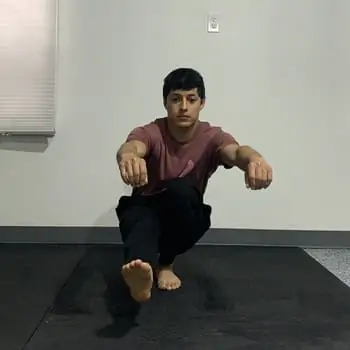 As I’ve already hinted, my approach to teaching the pistol squat works from the bottom up, as opposed to the more common approach of dropping down onto lower and lower surfaces.
As I’ve already hinted, my approach to teaching the pistol squat works from the bottom up, as opposed to the more common approach of dropping down onto lower and lower surfaces.
Chances are, if you’ve been trying to get a pistol squat for some time, you’ve been using that approach with little success. In the next section I’ll show you my preferred way of teaching the pistol squat, but as you’ve likely figured out from the assessment, there might be some background issues holding you back.
Once you’ve gone through the assessment and have figured out where you’re running into trouble with the pistol squat, the following resources will help you address your specific needs.
If Flexibility Was Your Biggest Issue…
When flexibility is the main thing holding someone back, they’re most likely dealing with restrictions in their squat, their ankles, or their back. These resources will help address those areas:
- Bodyweight Squat Tutorial – If you’re unable to get into a deep squat position, you’re going to have trouble with the pistol squat. This tutorial will help you shore up your squat so you can get back to working on pistols.
- Mobility Work for the Feet/Ankles – The bottom position of the pistol squat requires a fair amount of mobility in the ankles. This tutorial will help you get your ankles moving well so they can handle that load.
- Fix Up Your Spine – If you find yourself rounding forward a lot in the pistol squat, you’ll benefit from working on mobilizing your spine so you can balance yourself better.
- Elements Course – One way to address all of the above is by using the targeted locomotive exercises we teach in our Elements course. The course is designed to help you move better by improving your squats and mobility throughout your body.
If Strength or Balance Was Your Biggest Issue…
Since most people are not used to controlling their weight on one leg, as is necessary in the pistol squat, strength and balance are a big issue for many people. These resources will help.
- Front and Back Scales – These two exercises look simple but they’re two of the best exercises for building serious single leg strength and balance. This is one of my favorite precursor exercises for the pistol squat.
- Bodyweight Leg Strength – This is a compilation of a number of different exercises that will specifically help you build up the strength and balance you need for pistol squats. Working on these in conjunction with your pistol squat work will help you nail the pistol in no time.
- Bodyweight Circuit Video Routine – Get our free 6-exercise workout routine to build foundational strength throughout your body.
Pistol Squat Progressions: The “Bottoms-Up” Method
After figuring out what’s holding you back and addressing those weaknesses with the appropriate resources, it’s time to look at a better way to train the pistol squat. This method has worked for hundreds of clients who had struggled with this skill for a long time.
In this video I’ll show you my preferred way of teaching the pistol squat.
| How to Do a Pistol Squat | |
|---|---|
| #1 - Deep Squat | • Start by making sure you can get into a deep squat, bringing your butt close to your heels while keeping a straight back. • Work on that until you are ready to move on to the next step. |
| #2 - Roll Back | • Grab your ankles in the squat position and roll back, letting your butt come off the ground a bit. |
| #3 - Roll Back Up Into the Squat | • Holding on to your ankles, roll your body back up into a deep squat position. • Work on this progression until you feel comfortable enough to move on. |
| #4 - Extend One Leg | • Roll your body up into a squat position, but this time, keep one leg straight, and pop up very slightly with your bent leg. |
| #5 - Pop Up to Standing | • Work on popping up a little higher each time you roll up, until you can pop all the way up into a standing position. |
| #6 - Reverse Direction | • Next, you’ll go in the opposite direction: Stand up and squat back, keeping one leg straight, then roll back into a supine position. |
| #7 - Do a Full Pistol Squat | • Work on the previous progression until you can squat down with control, and stand back up with control. |
The biggest reason I teach the pistol with this “bottoms-up” method is because the hardest part of the pistol squat is not – as most people assume – the descent. It’s being stable in the bottom position and having the strength to stand up with control.
Using this method will help you get stronger in that bottom position and slowly build up the strength to stand up with control.
Extra Pistol Squat Form Tips
Starting from the bottom and going up gives a better sense of the correct positioning at the bottom. This is key to getting the pistol, as you can waste quite a bit of energy if you are pushing through your body incorrectly. It’s also crucial to be comfortable in this position and to be able to pause and maintain balance and control.
It takes time, so beginning every rep in this bottom position will improve your form and strength at every session.
The pause at the bottom is great for correct form, but it also helps develop strength from a “dead stop,” as there’s no stretch reflex from dropping down fast from the top and “bouncing” off the bottom. Doing that might help you to get the rep, but it won’t help you get as strong as doing it the right way.
This video will offer some further tips on doing pistol squats with the best form possible:
Just as you improve your positioning by practicing at the bottom, you will learn to better recruit your hips this way. Conversely, when dropping down from the top and coming up again, there can be a tendency to emphasize the quadriceps and neglect the powerful glutes and hamstrings.
Focus on the details and you’ll get much farther than if you skip them over.
FAQs: Answers to Common Pistol Squat Questions
I know the pistol squat can seem daunting, and we’ve gotten a lot of questions regarding the specifics of this skill. Below, I’ll address some of the most common questions we’ve received, which will (hopefully) ease any concerns you may have.
Is it normal to feel a stretch in the front of the shins and front of the ankle? Is that a “part of the process” and will it go away after I become more flexible, or should I work on my flexibility first?
Yes, this position is, for many people, not a normal everyday posture to be in. So there is going to be a “breaking in” period where your body adapts to the movement.
This is normal and natural and also indicates that you don’t want to progress too fast or force yourself into positions you aren’t ready for. This is why we emphasize proper form and deliberately going through the steps we show. Nothing slows you down more than getting injured.
Will pistols improve my jumping?
Well, the ability to do pistol squats correctly will definitely make your legs stronger. But that may or may not improve your vertical jump.
There are a lot of factors involved in jumping. Jumping is a whole body movement involving strength, timing, rate of force development, and other factors to improve height, speed, and accuracy.
My legs rotate out quite a bit at the hips and I also pronate (I’m flat footed). Is this going to make it really hard to be successful at the pistol?
It may make it harder, but it doesn’t necessarily mean you won’t be able to do it. You’ll have to be more aware of your foot/ankle and knee positioning and work harder to keep the straight alignment between them. Doing this will get you in the best positioning for your muscle recruitment and power.
My knee travels forward of my toes, it’s just the way I’m built. Why would you emphasize keeping it back?
It isn’t because you’ll have a problem with the knees going over the toes. We aren’t perpetuating the myth that it will hurt your knees by doing that.
Rather, you’ll get a better pistol if you think of sitting back behind the foot rather than trying to lean forward.
It takes a lot of hip mobility to get the butt to the heel and the chest to the knee. So this improves your hip mobility and also creates a better angle for the use of your hip extensors (gluteals and hamstrings), which can create a lot more force than just your quadriceps.
I notice your low back is rounded at the bottom of the pistol squat. Isn’t it better to be neutral? Aren’t you going to hurt your back?
No. The back doesn’t need to be neutral. There’s no reason it would need to be, as it’s not bearing weight. It’s made to bend, and if you drop the hips low, most people will need to bend the spine.
Again our bodies are meant to move and have options for movement. Back flexion and extension in the full range without pain is exactly what we want to have.
Would I have to be much stronger in my (barbell) full squat to be able to do a pistol?
There’s no accurate approximation. Pistols require completely different balance and mobility than a barbell squat. It’s not a comparable skill. Just practice the pistol, and you can get one, regardless of what your barbell squat looks like.
How would I adjust these instructions to make it more explosive? I do CrossFit and one of the workouts is to do as many reps as you can for time.
The first thing is to make sure your pistol form is perfect. And I really do mean perfect. Adding explosive movement sounds nice, but if your regular pistol form is super-solid, you’ll be getting stronger as you practice.
Over time, you can bang them out more easily, and they take less time. Eventually, they will be so fast they are explosive.
Let explosiveness be a byproduct of great form and great strength – don’t chase it as a goal.
What muscles does the pistol squat work exactly?
It’s best not to think in terms of which muscles are worked. This isn’t a bodybuilding exercise – it’s a movement exercise. If you do it right, you’ll be using most of the large muscle groups together rather than targeting a specific muscle for hypertrophy.
Squats are easy. Pistols feel impossible. Is there something else I can do?
We know how hard the pistol can be, and it makes sense given the mobility and control you need to do it right. Another movement you will want to try is the shrimp squat. We compare the pistol and shrimp squat to help you understand which is best for you.
How the Pistol Squat Will Help You Go Further in Your Physical Practice
There are some skills you might practice as a goal in and of themselves, but the pistol squat (in my opinion) isn’t one of them. There are so many far reaching benefits you’ll get from learning the one legged squats that will help you do a whole lot more in the future.
- The balance you’ll achieve by mastering this skill will help you with just about any skill or activity you’ve got on your mind. Balance is important for everything from single leg deadlifts, to shrimp squats, to stand-up paddleboard.
- The strength you’ll build in your legs with the pistol squat will help you work on exercises and activities that require a good amount of leg strength, including jumps, climbing, parkour, and more advanced bodyweight or weighted leg exercises.
- Your improved ankle and hip mobility from training this skill will help you feel more comfortable in a deep squat and can help you work on any of the exercises/activities just mentioned, as well as additional flexibility work.
And there are many ways to take the pistol squat itself further. Here are some examples:
Explore Ways to Get Into and Out of the Pistol
Here’s one example of how you can add twists and turns into your pistol squat practice:
Add Weight to Your Pistol Squat
This is only something I’d recommend once you’re very comfortable with unweighted pistol squats, but here’s one way GMB Lead Trainer Eduardo steps up his pistol game:
Practice Pistol Squats on Different Surfaces
Here you can see how GMB Trainer Verity Bradford makes her pistol squat practice more challenging by doing them on a narrow beam. This ramps up the balance challenge.
Combine the Pistol With Other Movements
Once you’re comfortable with the pistol squat, combining it with other movements is a great demonstration of real ownership of this skill.
Behind the Pistol Squat
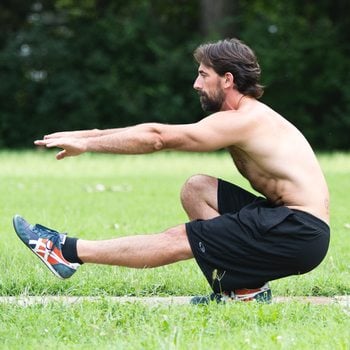 The things that make the pistol squat great—the impressive strength, mobility, and control it demands—are exactly the things that make it really hard.
The things that make the pistol squat great—the impressive strength, mobility, and control it demands—are exactly the things that make it really hard.
Many people, when they first try training for a difficult skill like the pistol squat, decide to back up before pushing ahead.
If you think that improving your foundational strength and endurance will help in your training (for the pistol squat or any other activity) start with our Integral Strength program.
It’s an 8-week program designed to build practical, dynamic strength for any physical activity or movement skill. Plus, we’ve included programming tips so you can tailor it to your goals.
Get Stronger and Move Better for Activities You Love
Integral Strength is a skill-based strength program that helps you build practical skills and strength that carry over into your beloved daily activities.
